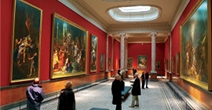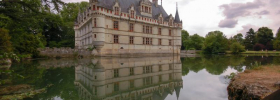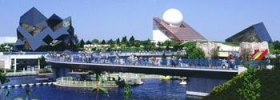 Home
Home- > Tours
- > Provence-Alpes-Côte-d'Azur
- > Vaucluse
- > Avignon
- > Avignon, city of the poes in provence
Avignon, city of the poes in provence
| Topic | Sciences and discovery |
| Departure | AVIGNON (84) |
| Details | With its bridge, famous the world over in the beloved children's song, the Palace of the Popes, testimony to its prestigious past as Capital of Christianity in the Middle Ages, Avignon offers grandiose architecture, ranked among UNESCO's World Heritage. The Avignon theatre festival in the summer has been the international meeting point for contemporary creation for the 60 years. Avignon is also the ideal base for exploring Provence - the Luberon, the Apilles, Camargue and all the beauty of Provence. Avignon also means Provencal cuisine and Côtes du Rhône wines, discovery and lifestyle. |
Discover Avignon
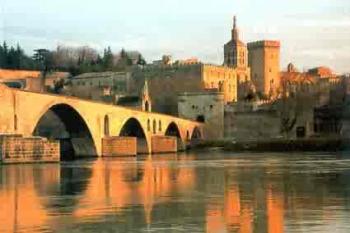
This is one of the rare French cities preserved its old ramparts, its historical centre, composed of the palace of the popes, the episcopal collection, of the Rock of Doms and the bridge of Avignon, it was classified World heritage of UNESCO under criteria I, II and IV.
Artistic and cultural window, fame of its principal festival known under the name of festival of Avignon, largely exceeded the French borders.
Avignon isn't a simple city, it's an work of art, a permanent show, which is offered to the visitors. Several excursions permit to discover the soul of the city.
You will be able to appreciate the Rue des Teinturiers and its famous water wheels, The Palais des papes, the jardins du Rocher des Doms and the heart of town listed historics monuments.
In following the tracks of Joseph Vernet, you will also be able to see most of Avignon museums, while the excursion of Carreterie will lead you until the ancient Seminaire of Sainte Grande.
Visits will permit you to travel through around Avignon and profit of its environment.
These excursions are the opportunity to profit of hidden marvels of an illuminate city by beauty.
To see: Collection Lambert, Calvet museum, petit Palais museum, Avignon's Bridge, Pope's Palace and Collegiate Church of Saint-Pierre.
Accommodation nearby
Walk of Doms
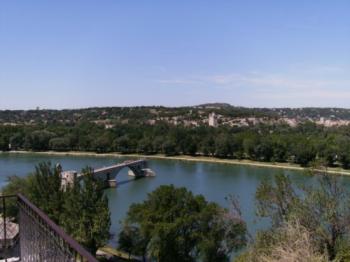
On this walk you will encounter the main landmarks of the city, The Promenade des Doms encircles the historic core of Avignon, which has been inscribed on UNESCO’s World Heritage list by the Convention of Berlin, 1995. One of the chielf architects of France’s Monuments Historique has called it the « Acropolis of Avignon ». It is one of the most beautiful sites in the world.
- Place du Palais
The Place du Palais-des-Papes stands out as the city’s most remarkable architectural ensemble. Because of its exceptional character, due more to chance to planning, it has figured among the sites included on UNESCO’s World Heritage list. The east side is dominated by the facades of the Palais des Papes and the Cathédrale Notre-Dame-des-Doms. To the west, the imposing and heavily ornamented facade of the Hôtel des Monnaies (constructed under the legation of Cardinal Borghese in 1619) is found side by side with buildings that sometimes demonstrate traces of past architectural moments, such as the Tour (Tower) de l’Officialité.
The north side of the plaza is enclosed by the elegant Renaissance facade of the Petit Palais. A stroll in the charming Doms gardens that overlook the plaza affords a wonderfull view
- Hôtel des Monnaies
The Hôtel des Monnaies is the earliest private Baroque monument in Avignon. A large inscription announces that is was built in 1619 by the Vice-Legate Jean-François de Bagni (1614-21), and that it is dedicated to Paul V, the reigning Pope.
The ornementation on the ground floor is interrupted by the central door an four windows. The rest of the facade is completely blind, and presents an extravagant sculptedécor. Above the dedication the coat of arms of Paul V is borne by angels and crowned with the pontifical tiara. Eagles and dragons, the charges of the arms of the Broghese family, can be seen on enormous garlands of fruit or perched upon the upper balustrade : The Vice-Legate probably also wished to honor the titular Legate of Avignon, Scipion Cafarelli (1607-21), the Pope's nephew, who was commonly called Cardinal Borghese.
- Hôtel Calvet de la Palun
This Hôtel seals the southern side of the Place du Palais. It was built in 1789, making it one of the last hôtels built under the pontifical proprietor-ship of Avignon. Designed by Jean-Pierre Franque, it " embodies a fine reminiscience of thePetit Trianon " (A.Breton).
- Archives départementales
The departmental Archives owe their origin to an idea from the revolutionary period : the gathering all documents necessary for the functioning of the administrative seat of the department in one place.
On october 26, 1796 the Departmental Archives were initiated. They consisted of documents from administrative, judiciary and religious establishments that had been abolished, documents confiscated from fleeing emigrants, and documents from new departmental intitutions. This is how the charter of the bishopric of Avignon, archives from Galéans-Gadagne family, the prefecture and the regional council, civil registries and the Journal officiel were conserved in the Vaucluse.
- Cathédrale Notre-Dame-des-Doms
The Cathédrale Notre-Dame-des-Doms - which today is a metropolitan basilica - stands in a prominent position on the rock that overlooks the bend in the Rhône. Its silhouette stands out distinctly against the neighboring mass of the Palais des Papes, though the contrast is harmonious because of the proportion of its square bell tower. This serves well as the western facade, as the narrow dimensions of the edifice are emphasized by the lack of the transept. Erected in 1859 at the top of the recently re-gilded bell tower, a lead statue of the Virgin is visible from all over the city, which she protects with her outstretched arms.
- Cathedral relics
The lateral chapel built by Pope John XXII to house his tomb shelters a rich collection af liturgical ornaments and ecclesiastical plates.
Avignon and Provençal goldsmiths of the seventeenth and eighteenth century are all well represented, while a rare set of Spanish metal works from the fifteenth to the eighteenth century are from a recent donation. At the time of this addition, the baldaquin tomb of John XXII, made by an English stonecutter around 1320, was cleaned and returned to its original location. In the adjoining sacristy, the cabinets are topped by numerous reliquaries. These cabinets are the work of a joiner who later became a comtat politician, Agricol Perdiguier, for his Mémoires d'un compagnon (1854), as well as for the hinged cope chest (a cabinet for storing copes), which is still in use.
- Rocher des Doms
The Rocher des Doms is the cradle of the city of Avignon. Signs of habitation dating to the ned of the Neolithic era have been discovered on this bluff, such as a remarkable anthropomorphic stele. As a shelter and refuge for the avignonnais, it was fortified during Roman and Medieval periods, and its plateau soon encompassed cemeteries, chapels and mills. Large ramps permitted entry in the seventeenth century. The first steps towards transforming the Rocher into gardens were made in 1831 and continued throughout the nineteenth century. It was during the Second Empire that the gardens began to assume their current appearance. At that point pools were added and flora brought from the jardin des Plantes.
Accommodation nearby
Walk Promenade Joseph Vernet
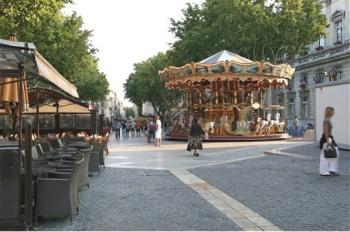
The Promenade Joseph-Vernet traces the western portion of the city. It gets its name from Avignon’s most famous painter, known for his seascapes, his series Ports de France, and his long career in the service of the king. It hugs close to Rue Saint-Joseph, it devenir to art and covers most of the museums.
- Place de l’Horloge
In Roman times a forum spread over the space now occupied by the plaza, Theater and City Hall. A simple crosswomen in the Middle Ages was the site of the city’s main market, with its butchers and herb sellers. Soon after the consuls acquired the livrée d’Albane for administrative purposes in 1447, it became clear that the plaza would have to enlarged. Construction lasted more or less continuously until the end of the nineteenth century.
- L’Hôtel de ville
In 1447 the councils of Avignon bought the Gothic Livrée d’Albane from the Benedictines of Saint-Laurent with the intention of making it into a public building and transforming the tower into a belfry. It wasn’t until the nineteenth century that the regional council decided to provide the city with a genuine Hôtel de Ville (City Hall). The city’s architect, Joseph-Auguste Joffroy drew up the plans. To brighten the facade the architect Feuchères contribued a balcony supported by Corinthian columns and added peristyle columns.
- Tour du Jacquemart
The tower is the last vestige of the forteenth-century livrée (Cardinal’s palace) that became the City Hall in 1447, and is now surrounded by nineteenth-century buildings. This maneuver was criticized by Prosper Mérimée : « The tower is to be preserved like the partridged in Pithiviers, they are put into pâté with their heads sticking out ».
The painted coat of arms sculpted onto a keystone attests to the constructor’s indentity, Cardinal Audouin Aubert, nephew of Pope Innocent VI. Built between 1352 and 1363, remains of painted decoration (mock tapestries and foliage) can be discerned on two levels. Sculpted brackets and glazed tiles also date back to the original construction.
- Théâtre municipal
Avignon has a special relationship with the theater and the opera.
A taste for music has prevailed at least since the fourteenth century, and the activities of the municipal theater in the nineteenth century played an essential role in local life. Due to the use of already-present spaces, such as jeux de paume converted for representations, it was not untill 1732 that a theater was erected, on the Place Crillon.
In the nineteenth century this venue was considered too small and inadequate, and the city decided to construct another on the site of the Couvent of the Dames de Saint-Laurent. Completed in 1825, it bore a flat Greco-Roman style facade, with two superimposed colonnades surmounted by eight allegorical statues. It was designed by two Avignonnais architects, Bondon and Frary.
Accommodation nearby
Walk of the Teinturiers
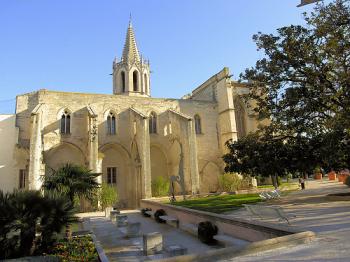
This promenade covers the pesdestrian zone of the old city center. It culminates near the Sorgues River, on the plain tree-lined, picturesque Rue des Teinturiers (« Dyers Street »), whose charming paddle wheels once contributed to the city’s prosperty.
There are also among the most lively streets in the city –to the extent that this might also be called the Promenade des Boutiques since window-shopping may inevitably be an important part of the stroll.
- Temple Saint-Martial
The monastery and college of the Benedictines of Cluny was one of the most sumptuous in fourteenth-century Avignon. It held the notable and macabre tomb of Cardinal de la Grange (now in the Musée du Petit Palais), as well as the cenotaph in memory of its founder, Urban V.
In March 1363, Urban granted the Cluny Benedictines the palace of the kings of Majorca. This donation was meant to compensate for the loss of the cluniac priority at Notre-Dame-de-Belvédère that had been annexed by John XXII during the construction of the papal palace at Pont-de-Sorgues. It was not until the second half of the fourteenth century that a Cluniac establishment was erected in Avignon.
The Abbot of Cluny, Cardinal Androin de la Roche, occupied the site and enlarged it with purchases of neighboring houses and gardens. He donated this ensemble to the order in 1369, on condition that is receive eighty four monks, half of whom had be students. It was only in 1378 that the priory-college of Saint-Martial was founded by Cardinal Pierre de Cros, who undertook the construction of the church in 1383.
The church and its belfry were completed after the death of de Cros, and was paid for by his estate.
Cardinal Jean de la Grange, former Bishop of Amiens and councilor to Charles V, recommenced the work for the last bay and the apse, where he intended his tomb to be placed. All work was completed c.1402, and the tomb was put in place a few years later.
The building was considerably transformed by the ravages of the French Revolution. In 1881, the apse and the first two bays were converted into a Protestant sanctuary. The third bay was used as a vestibule, and in 1700 it was provided with a majectic doorway by the famous architect Pierre Mignard. The monastery buildings, also designed by Mignard, were partially demolished in 1856-57, when the Cours Bonaparte (now the Cours Jean-Jaurès) was laid. The road-side facade was reconstruted, and the building served as a tax and then a tourist information center. Remains of a gallery from Saint-Martial’s cloister (with a floor-level reconstitution) can be seen in the public gardens ; as can the prominent buttressed chevet and the belfry.
The Saint-Martial Monastery, like that of the Celestines, attests to the new influence of the flamboyant style, which until then had not appeared in Avignon. The church has a simple plan : a nave with five bays, no side aisles, and a pentagonal apse. It is characteristic by virtue of its apse, distinctively higher than the nave, from which it is separated by a diaphragm wall bearing the arms of Cluny and of Etienne de la Grange, the brother of the Cardinal.
A highly varied flamboyant vocabulary (identical with that of the outer walls) is displayed through the upper reaches . Above alternating plain and decorated walls the six vault compartments are linked by pendant boses bedecked with the arms of the La Grange brothers. These, along with the ornamented ribs in very high relief (perforated quatrefoil freizes, cusps), and the console with shield-bearing anges in vigorous postures, attest to surprising decorative exuberance.
Walk around the tourist office to Rue Jean-Henri-Fabre where you will find the entrance to the Eglise Saint-Martial. Then, at the traffic light, turn left onto Rue des Trois-Faucons. Number 14, the mid eighteenth-century Hôtel de Luynes, Further along, Hôtel de Rochegude at numbers 4-6, was restored by the Côtes-du-Rhône Interprofessional Commitee.
The facade was designed by Louis-François de la Valfenière in 1683. The magnificent iron guard rail on the front projection’s balcony was added in 1732.
Turn right on Rue du Roi-René, on the other side of Place Saint-Didier.
- Eglise Notre-Dame-la-Principale
This is one of the seven original churches of the Avignon parish that extended in a circle around the Rocher des Doms and the cathedral. The exact date of its enlargement in the fourteenth century is difficult to place. During the invigorated building activity that accompanied the move of the papacy to the city, north and south chapels were added to the single nave. The gutter-wall and simple belfry (the rectangular first level is surmounted by an octogonal bell tower with narrow windows) are located on the south side.
The church was repartitioned during the Revolution, and only the nave and lateral chapels were maintained for workship. These were separated from the choir by a newly-erected wall. At the beginning of the nineteenth century it was transformed into a chapel for the White Penitents. The current facade dates from the nineteenth century and is the work of Abbot Pougnet. The eastern entrance is surmounted by a pediment with kneeling men in the garb of penitent brothers on either side of Christ.
- Rue des teinturiers
Rue des Teinturiers is without doubt one of the most picturesque streets of the old city. It follows the course of a branch of the Sorgue River, which originates at the Fontaine-du-Vaucluse, and formely fed the moat of the twelfth-century ramparts (at the canal is now covered over). In the fifteenth century it was called Rue du Cheval-Blanc, after a planted with mulberries, thanks to the Confrérie Notre-Dame-du-Salut.
n the eighteenth century the water was used in printed cotton factories, an industry that was particularly profitable at the time, to be reactivated in the nineteenth century. Eventually other industries took over the sites, harnessing the power of the Sorgue with large paddlewheels.
A beautiful gothic house, the Maison du Quatre de Chiffre, is located at the corner of Rue Guillame-Puy.
Accommodation nearby
Walk of Carreterie

This walk will enable you to better understand the city’s structure and arrangement. The field of exploration extends from the Rocher des Doms to the far eastern point of the ramparts. The outlines of the ancient Roman city are marked by Rues des Trois-Colombes, Campane, and Paul-Saïn. All the aristocratic dwellings are located at the city’s core. Little hamlets developed at the city’s Matheron and Infirmières gates, where mendicant orders (Carmelites, Augustines) established monasteries.
Further on, larger urban zones were established in the fourteenth century, with the building of houses for skilled and unskilled workers. Thus peripheral proliterian sectors developed outside the walls, around Rue Carreterie.
During the Revolution these neighborhoods professed allegiance to the « red » cause, in opposition to the « white » of the center.
From place Pie to the séminaire Sainte-Garde
- Place Pie
The destruction in 1562 of the house of Jean-Perrin Parpaille, son of a former director of the University of Avignon, and an ardent Catholic converted to Protestantism, freed up the plaza that came to be called the Place Pie (Pope Pie VI). Immediately a colonnad was erected, the first stage of what became the fruit and vegetable market place. More houses were torn down and this incarnatin of the market was completed in 1624.
Jean-Baptiste Franque’s new project comprised of stone arcades beneath storage lofts (called « sextiers » ) required its demolition. During the Revolution it was renamed Place d’Armes, continuing as a market for agricultural commerce, and eventually displacing the Place de l’Horloge in this capacity. In 1844, in the western portion of the plaza, a small covered market went up in front of the Commandery. This metal structure increased the market’s commercial capacity.
During the Second Empire, Franque’s structure was in turn torn down, and Rue Thiers was laid (1869-76), opening onto the plaza. The plaza was further enlarged with the unfortunate destruction of the Commandery, and in 1899 a large metal structure was erected to respond to the growing market needs of the city. These market halls were demolished in 1972, replaced by a new edifice with a parking garage at its top ; a discouraging accomplishment, despite recent renovation.
- Chapelle de la Visitation
The chapelle du Couvent de la Visitation was built between 1631 and 1638. The inscription on the facade indicates that the sponsor was legate indicates that the sponsor was Cardinal Marion Philonardi, vice-legate to the Pope. This architectural chef-d’œuvre was conceived by François de Royers de la Valfenière. The interior plan is in the shape of Latin cross. The transept of four semicircular arches supports a drum and pendentive cupola.
The east-oriented nave has three barrel-vaulted spans, with the nun’s choir in the center. The facade is an example of what has been called (« incorrectly », A.Breton) the Jesuit style. It has two lines of two superposed orders, composite below and Corinthian above. A powerful cornice separates the levels and emphasizes their horizontality. The lower register is enlivened by a rhythm of breaks that the entablature joins and underlines. The upper has a central bay, is framed by volutes, and is surmounted by a triangular pediment. The rich sculptural ornamentation in the center at the level of the capitals joins forces with the ensemble for a wonderfully balanced and charming construction.
- Hôpital Sainte-Marthe
In 1354 the knight and judge Bernard Rascas and his wife Louise founded the Hôpital Sainte-Marthe. The Couvent des Trinitaires was attached to the site to provide spiritual and material assistance to provide spiritual and material assistance to the ill.
The couple devoted 10,000 gold florins to the project, which was an appreciable sum at the time, considering that a few years earlier the Pope had purchased the city of Avignon and its territories for 80,000 florins. The donation was supplemented upon Bernard Rascas’death. Public recognition of his largess quickly led to the qualification of his name with « Saint ». This is why the hospital and the deed were often designated with the name Saint Bernard.
- Clocher des Augustins
This was one of the earliest Augustine convents in Provence, first occupied in the second half of the thirteenth century outside the city walls near the Portail Matheron, not far from the Carmelites who were located on the same street. The church was apparently complete by the beginning of the fourteenth century and is probably one of the first examples of Gothic Avignonese style. It was later enlarged and renovated by John XXII, who added chapels to the eastern portion of the church. At the time, this neighborhood was growing rapidly, with artisans as well as small merchants. The Augustines began construction of a bell tower in 1372 and completed it in 1377. It is the only visible remnant of what was one of the largest convents in Avignon.
- Eglise et cloître des Carmes
The Avignon mendicant convents, sold off as national property, were destroyed in the Revolution. As the solde survivor of this group, the Carmelite church remained with its cloister, protected by its dedication to worship. Beginning in 1803, it became the seat of the Saint-Symphorien parish, taking its name, after the secularization of the former church on the Rue Banasterie. It is possible that the mayor renovation and consolidation work carried out in the Carmelite convent during the seventeenth and eighteenth centuries were a decisive factor in this choice.
The importance of this convent is also reflected in the local toponomy, with a public square bearing the same name. The carmelites were established in Avignon, outside the city walls near the Portail des Infirmières, during the second half of the thirteenth century. When the Avignon papacy was established, reconstruction of the church was begun thanks to the generosity of John XXII, followed by Clement VI. This undertaking was part of extensive works affecting several monasteries (the Dominican, Augustine and Cordeliers), promoted by various popes and cardinals.
- Chapelle des Pénitents noirs
The brotherhood of the Pénitents Noirs de la Miséricorde was founded in 1586 by a colonel in the papal infantry, Pompée Catilina. Its mission was to spiritually and physically accompany prisoners, to assist those condemned to death, and then, in the eighteenth century, to attend to the needs of the mentally deranged, for whom a hospice was attached to the chapel.
The Pope granted the Pénitents Noirs the privilege of releasing one condemned prisoner each year. Since their order was dedicated under John the Baptist, this took place on September 8, the day of his beheading. In 1617 Pope Paul V permitted this « delivrance » to occur on any day of the year, to be announced during important solemn ceremonies.
Accommodation nearby
Avignon, in the course of Rhône
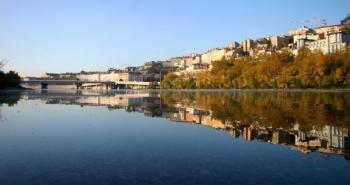
All throught history the Rhônes river has contributed to the economical and cultural wealth of the city.
Small or large, the boats take the same way to Lyon, Arles or further destinations.
Formerly, the trail ferry made it possible to join theisland of Barthelasse for Sunday walks. Today, banks of the Rhone to the accesses of the bridge d' Avignon were restored and the river shuttle " the City of Avignon " allows to reach this " free; green lung of the " city; , more green big space d' Avignon.
Boats walks accomodate you and propose another glance to you on the city, sight of the Rhone and many excursions at the beginning of Avignon. Then, why not let to you try? Avignon in Boat
A visit of the Saint-Bénezet Bridge and one strolls by boat on the Rhone.
Accommodation nearby
Latest news on : Avignon, city of the poes in Provence
Tourism near
 Visit the city of Avignon
Visit the city of Avignon - 8 Museum
- 22 Monuments
Tours
 Route of Wines: Côtes de Rhône southern zone
Route of Wines: Côtes de Rhône southern zone
 Visit tourist spots in Vaucluse
Visit tourist spots in Vaucluse
 The Gard department
The Gard department






















